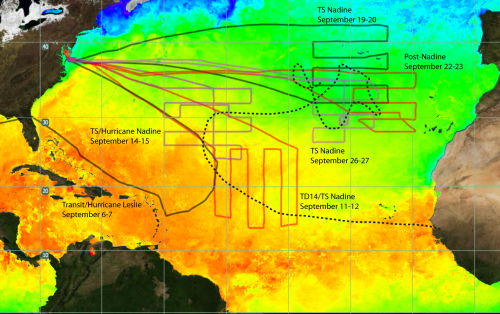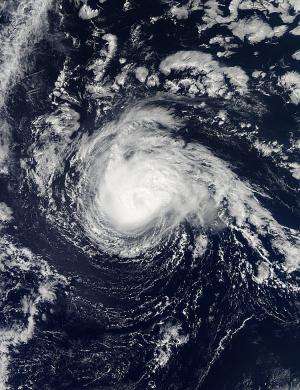NASA's HS3 mission thoroughly investigates long-lived Hurricane Nadine

NASA's Hurricane and Severe Storm Sentinel or HS3 scientists had a fascinating tropical cyclone to study in long-lived Hurricane Nadine. NASA's Global Hawk aircraft has investigated Nadine five times during the storm's lifetime.
NASA's Global Hawk also circled around the eastern side of Hurricane Leslie when it initially flew from NASA's Dryden Research Flight Center, Edwards Air Force Base, Calif. to the HS3 base at NASA's Wallops Flight Facility, Wallops Island, Va. on Sept. 6-7, 2012.
Nadine has been a great tropical cyclone to study because it has lived so long and has strengthened to hurricane status a couple of times, and then weakened back into a tropical storm. Hurricane Nadine is an anomaly because it has been tracking through the North Atlantic since Sept. 11, when it developed as the fourteenth tropical system of the hurricane season.
Longest-lived Tropical Cyclones
As of Oct. 2, Nadine has been alive in the north Atlantic for 21 days. According to NOAA, in the Atlantic Ocean, Hurricane Ginger lasted 28 days in 1971. The Pacific Ocean holds the record, though as Hurricane/Typhoon John lasted 31 days. John was "born" in the Eastern North Pacific, crossed the International Dateline and moved through the Western North Pacific over 31 days during August and September 1994. Nadine, however, is in the top 50 longest-lasting tropical cyclones in either ocean basin.
First Flight into Nadine
On Sept. 11, as part of NASA's HS3 mission, the Global Hawk aircraft took off from NASA Wallops at 7:06 a.m. EDT and headed for Tropical Depression 14, which at the time of take-off, was still a developing low pressure area called System 91L.
At 11 a.m. EDT that day, Tropical Depression 14 was located near 16.3 North latitude and 43.1 West longitude, about 1,210 miles (1,950 km) east of the Lesser Antilles. The depression had maximum sustained winds near 35 mph. It was moving to the west near 10 mph (17 kmh) and had a minimum central pressure of 1006 millibars.
NASA's Global Hawk landed back at Wallops Flight Facility, Wallops Island, Va., on Sept. 12 after spending 11 hours gathering data in the storm, which had strengthened into Tropical Storm Nadine during the early morning hours of Sept. 12.
The Global Hawk, one of two associated with the HS3 mission, sought to determine whether hot, dry and dusty air associated with the Saharan air layer was being ingested into the storm. This Saharan air typically crosses westward over the Atlantic Ocean and potentially affects tropical cyclone formation and intensification. During its 26-hour flight around Nadine, the Global Hawk covered more than one million square kilometers (386,100 square miles) going back and forth over the storm in what's called a "lawnmower pattern." The Global Hawk captured data using instruments aboard the aircraft and also dropped sensors called sondes into the storm. These sondes are small sensors tied to parachutes that drift down through the storm measuring winds, temperature and humidity.

Second Flight into Tropical Storm Nadine
The Global Hawk investigated Tropical Storm Nadine again on Sept. 14 and 15. During its 22.5 hour flight around Nadine, the Global Hawk covered more than one million square kilometers (386,100 square miles) going again went back and forth over the storm in another lawnmower pattern.
"During the flight, Nadine strengthened from a tropical storm to a hurricane despite being hit by very strong westerly winds at upper levels and very dry air on its periphery," said Scott Braun, HS3 Mission principal investigator from NASA's Goddard Space Flight Center, Greenbelt, Md. Data from this flight will help scientists determine how a storm like Nadine can intensify even in the presence of seemingly adverse conditions.
Third Flight into Tropical Storm Nadine
NASA's Global Hawk unmanned aircraft departed from NASA Wallops at 2:42 p.m. EDT on Wednesday, Sept. 19 and crossed the Atlantic to take additional measurements in Tropical Storm Nadine. Both the Global Hawk and NASA's TRMM satellite noticed that Nadine had continued to display tropical characteristics, indicating that it had not transitioned to an extra-tropical storm. An extra-tropical storm is one that loses its tropical characteristics, such as when the core of the storm changes from a warm core to a cold core, like a typical mid-latitude low pressure system that is associated with fronts. At that time, Nadine was located in the Atlantic a few hundred miles southwest of the Azores Island.
The science portion of the third flight was completed on Sept. 20. Scientists reported that they obtained excellent data from the dropsonde system, which showed some winds on the western side of the storm still reaching 60 knots (69 mph/111 kmh) at middle levels and possibly one measurement of near 60 knots (69 mph/111 kmh) near the surface. The data suggested that Nadine was still a tropical system rather than an extra-tropical system.
The three science instruments aboard the Global Hawk performed extremely well, transmitting data back to NASA Wallops for the scientists to analyze and discuss. The plane observed Nadine for more than 12 hours. Forecasters at the National Hurricane Center were using the data supplied by NASA's Global Hawk and noted in the discussion of Nadine at 11 a.m. EDT on Sept. 20, "The current intensity is kept at 45 knots (51.7 mph/83.3 kmh)…is in good agreement with dropsonde data from the NASA Global Hawk aircraft and AMSU [instrument] estimates."
Fourth Flight Over Nadine
The fourth science flight of NASA's Global Hawk over Nadine concluded when the aircraft landed at NASA Wallops on Sunday, Sept. 23. The HS3 mission scientists changed the flight path during the Global Hawk flight to be able to overfly Nadine's center that day.
"Measurements from dropsondes found wind speeds greater than 60 knots (69 mph/111 kph) at lower levels above the surface during that adjusted flight leg," said Scott Braun. "Despite the large distance of Nadine from the U. S. East Coast, the Global Hawk was able to spend about 11 hours over the storm."
Fifth Flight Over Nadine
The Global Hawk aircraft's fifth investigation of Nadine occurred on Sept. 26 with the aircraft returning to NASA Wallops the next day. While over Tropical Storm Nadine, the storm had maximum sustained winds near 60 mph (95 kmh). Despite adverse conditions, the storm re-intensified to a hurricane the next day, so the HS3 data captured the precursor conditions for intensification.
Provided by NASA's Goddard Space Flight Center





















